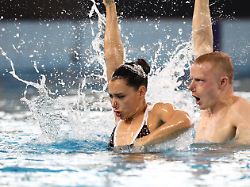“In Germany there are only four”
German exotic fights for recognition at World Cup
07/14/2023 3:18 p.m
Frithjof Seidel has only been a synchronized swimmer for two years. But he doesn’t need a long start-up period in his new career: he won European Championship silver with the team. Now it’s his first time at the World Cup.
From time to time Frithjof Seidel has to smile about his exotic existence. “Sometimes I find it amusing that, exceptionally, men have to fight for their rights to participate in the World Cup,” says the synchronized swimmer about the rare minority role of his gender: “In society it’s often the other way around.”
Seidel has already competed in world and European championships, but at that time as a water jumper. In 2021, after the actual end of his career, the Berliner was poached for synchronized swimming and, after a rapid development in performance, can already call himself a silver medalist at the European Championships.
In the title fights at the European Games in Kraków, he and the mixed team won the first synchronous medal for Germany in 40 years. Now he is facing his first World Championships as a synchronized swimmer – and is a real pioneer in Fukuoka: “I was happy and grateful that we took this step, that they took the risk of including me as an inexperienced athlete in the team take.”
The goal is the World Cup final
Only since this season have men been admitted to international team competitions. Although men were allowed to take part in mixed duet for the first time at the 2015 World Championships, Bochum’s Niklas Stoepel was the first German male synchronized swimmer at a World Championships in 2017. The title fights in Japan now mark the next step on the way to more diversity in the pool.
Seidel wants to be a pioneer and above all “visible”, he says. The 26-year-old is pursuing a clear mission when he starts on Saturday in the team in the new discipline acrobatics (3 a.m. CEST) and in the mixed duet (7 a.m. CEST): “I hope I can be a role model for future athletes.”
With silver in the free combination at the European Games, he has already given his cause the publicity and was the first man in the history of the European Championship to win a medal in a team. At the World Cup, the ambitions are different. The goal with his mixed partner Michelle Zimmer, who first brought him to synchronized swimming three years ago, and also in acrobatics is the final.
Visibility should create awareness
Since this year, more emphasis has been placed on acrobatics in synchronized swimming. This benefits the men thanks to their greater strength values. That’s why the team attaches particular importance to Seidel’s feedback. “Because of my physical condition as a man, I play a key role in the team freestyle, especially with lifting figures,” reported Seidel.
But he is optimistic about the future – also when it comes to other competitors. “I think a lot of people aren’t aware that this is a sport that anyone can do. But it’s a process and I hope that the current visibility will change people’s awareness a bit,” he says. He currently knows four synchronized swimmers in Germany: “Including me.”
The goal on the horizon is the Olympics. 2024 in Paris, men will be allowed to start in the team competition for the first time. “Next year it’s still rather unrealistic,” says Seidel: “But 2028 would be a goal, and there’s also hope that the mixed duet will also be included as a discipline. That would be a great opportunity.”
